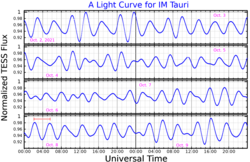Astronomy:44 Tauri
| Observation data Equinox J2000.0]] (ICRS) | |
|---|---|
| Constellation | Taurus |
| Right ascension | 04h 10m 49.86084s[3] |
| Declination | +26° 28′ 51.4365″[3] |
| Apparent magnitude (V) | 5.37 - 5.58[4] |
| Characteristics | |
| Spectral type | F2 IV[5] |
| Variable type | δ Scuti[4] |
| Astrometry | |
| Radial velocity (Rv) | 17.43±0.64[3] km/s |
| Proper motion (μ) | RA: −30.919±0.123[3] mas/yr Dec.: −35.105±0.072[3] mas/yr |
| Parallax (π) | 15.4199 ± 0.0863[3] mas |
| Distance | 212 ± 1 ly (64.9 ± 0.4 pc) |
| Absolute magnitude (MV) | 1.44±0.16[6] |
| Details | |
| Primary | |
| Mass | 1.89[6] M☉ |
| Surface gravity (log g) | 3.6±0.1[5] cgs |
| Temperature | 7000±200[7] K |
| Rotational velocity (v sin i) | 2±1[7] km/s |
| Other designations | |
| Database references | |
| SIMBAD | data |
44 Tauri, also known as HD 1287 and IM Tauri, is a star located about 210 light years from the Earth, in the constellation Taurus.[3] It is a 5th magnitude star, making it faintly visible to the naked eye of an observer located far from city lights. It is a Delta Scuti variable star, ranging between magnitude 5.37 and 5.58 over a period of about 3.5 hours.[4]
In 1966, Ivan Danziger and Robert Dickens discovered that 44 Tauri was a low amplitude variable star, with a period of approximately 3.22 hours.[9] In a follow-up study published the next year, they reported that the period was irregular, indicating beat phenomena, and they classified it as a δ Scuti variable.[10] In 1968, 44 Tauri was given the variable star designation IM Tauri.[11]
44 Tauri has been a popular object for detailed astroseismic and spectroscopic studies, because its very slow (relative to other δ Scuti stars) rotation speed of 3±2 km/sec does not complicate pulsation mode identification or greatly broaden spectral lines.[5][7][12] As of 2010, 44 Tauri had been found to pulsate with 15 independent periods, ranging from 1.89 to 4.52 hours.[5]
References
- ↑ "MAST: Barbara A. Mikulski Archive for Space Telescopes". Space Telescope Science Institute. https://mast.stsci.edu/portal/Mashup/Clients/Mast/Portal.html.
- ↑ "IM Tau". AAVSO. https://www.aavso.org/vsx/index.php?view=detail.top&oid=35247.
- ↑ 3.0 3.1 3.2 3.3 3.4 3.5 3.6 Vallenari, A. et al. (2022). "Gaia Data Release 3. Summary of the content and survey properties". Astronomy & Astrophysics. doi:10.1051/0004-6361/202243940 Gaia DR3 record for this source at VizieR.
- ↑ 4.0 4.1 4.2 Samus', N. N.; Kazarovets, E. V.; Durlevich, O. V.; Kireeva, N. N.; Pastukhova, E. N. (2017). "General catalogue of variable stars: Version GCVS 5.1". Astronomy Reports 61 (1): 80. doi:10.1134/S1063772917010085. Bibcode: 2017ARep...61...80S.
- ↑ 5.0 5.1 5.2 5.3 Lenz, P.; Pamyatnykh, A. A.; Zdravkov, T.; Breger, M. (January 2010). "A δ Scuti star in the post-MS contraction phase: 44 Tauri". Astronomy and Astrophysics 509: A90. doi:10.1051/0004-6361/200912914. Bibcode: 2010A&A...509A..90L. https://www.aanda.org/articles/aa/pdf/2010/01/aa12914-09.pdf. Retrieved 19 January 2023.
- ↑ 6.0 6.1 Civelek, R.; Kızıloğlu, N.; Kırbıyık, H. (October 2001). "Radial and Nonradial Oscillations of 44 Tauri". The Astronomical Journal 122 (4): 2042–2046. doi:10.1086/323078. Bibcode: 2001AJ....122.2042C.
- ↑ 7.0 7.1 7.2 Lenz, P.; Pamyatnykh, A. A.; Zdravkov, T.; Breger, M. (August 2007). "High-resolution spectroscopy of the δ Scuti star 44 Tauri: photospheric element abundances and mode identification". Astronomy and Astrophysics 471 (1): 237–245. doi:10.1051/0004-6361/200912914. Bibcode: 2010A&A...509A..90L. https://www.aanda.org/articles/aa/pdf/2010/01/aa12914-09.pdf. Retrieved 19 January 2023.
- ↑ "p Tau -- delta Sct Variable". SIMBAD. Centre de données astronomiques de Strasbourg. http://simbad.u-strasbg.fr/simbad/sim-basic?Ident=p+Tau+--+delta+Sct+Variable.
- ↑ Danziger, I. J.; Dickens, R. J. (August 1966). "Observations of Variable F-Type Stars with Short Periods". Information Bulletin on Variable Stars 150: 1. Bibcode: 1966IBVS..150....1D. https://ui.adsabs.harvard.edu/abs/1966IBVS..150....1D. Retrieved 19 January 2023.
- ↑ Danziger, I. J.; Dickens, R. J. (July 1967). "Spectrophotometry of New Short-Period Variable Stars". Astrophysical Journal 149: 55–72. doi:10.1086/149231. Bibcode: 1967ApJ...149...55D.
- ↑ Kukarkin, B. V.; Efremov, Yu. N.; Frolov, M. S.; Medvedeva, G. I.; Kholopov, P. N.; Kurochkin, N. E.; Kukarkina, N. P.; Perova, N. B. et al. (November 1968). "Identification List of the New Variable Stars Nominated in 1968". Information Bulletin on Variable Stars 311: 1. Bibcode: 1968IBVS..311....1K. https://ui.adsabs.harvard.edu/abs/1968IBVS..311....1K. Retrieved 19 January 2023.
- ↑ Zima, W.; Lehmann, H.; Stütz, Ch.; Ilyin, I. V.; Breger, M. (August 2007). "High-resolution spectroscopy of the δ Scuti star 44 Tauri: photospheric element abundances and mode identification". Astronomy and Astrophysics 471 (1): 237–245. doi:10.1051/0004-6361:20077201. Bibcode: 2007A&A...471..237Z. https://www.aanda.org/articles/aa/pdf/2007/31/aa7201-07.pdf. Retrieved 19 January 2023.
 |


